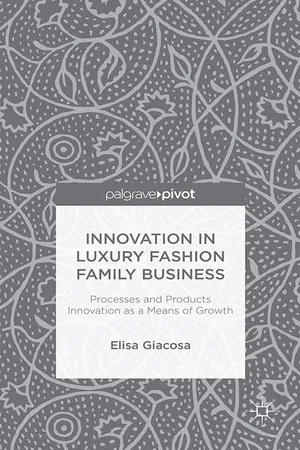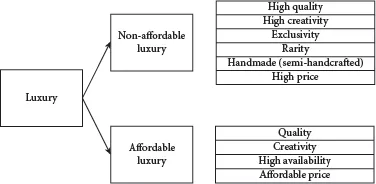
eBook - ePub
Innovation in Luxury Fashion Family Business
Processes and Products Innovation as a Means of Growth
This is a test
- English
- ePUB (mobile friendly)
- Available on iOS & Android
eBook - ePub
Innovation in Luxury Fashion Family Business
Processes and Products Innovation as a Means of Growth
Book details
Book preview
Table of contents
Citations
About This Book
A large number of family businesses operate in the luxury fashion sector which shows their importance as a source of growth, development and social and economic stability. This book analyses how a strategy of innovation in terms of products and processes can offer a competitive advantage to family businesses operating in the luxury fashion sector.
Frequently asked questions
At the moment all of our mobile-responsive ePub books are available to download via the app. Most of our PDFs are also available to download and we're working on making the final remaining ones downloadable now. Learn more here.
Both plans give you full access to the library and all of Perlego’s features. The only differences are the price and subscription period: With the annual plan you’ll save around 30% compared to 12 months on the monthly plan.
We are an online textbook subscription service, where you can get access to an entire online library for less than the price of a single book per month. With over 1 million books across 1000+ topics, we’ve got you covered! Learn more here.
Look out for the read-aloud symbol on your next book to see if you can listen to it. The read-aloud tool reads text aloud for you, highlighting the text as it is being read. You can pause it, speed it up and slow it down. Learn more here.
Yes, you can access Innovation in Luxury Fashion Family Business by E. Giacosa in PDF and/or ePUB format, as well as other popular books in Negocios y empresa & Negocios internacionales. We have over one million books available in our catalogue for you to explore.
Information
Topic
Negocios y empresaSubtopic
Negocios internacionalesPart I
The Family Business Phenomenon in the Luxury Fashion Context
1
The Family Business Model in the Luxury Fashion Context
Abstract: We established the context for the luxury fashion business, distinguishing in relation to the affordability of the products. Taking our cue from the Miller and Le Breton-Miller model (2005), we have attempted to create a new model, identifying a series of specific features of family businesses which represent a competitive advantage in the luxury fashion context, as they typify attitudes and values typical of family businesses. These particular features are the following: corporate heritage; long-term vision in investment strategy; specialization; internal and external relationships; tendency to innovate. These particular features affect the propensity to innovate, which is the core topic of the book.
Keywords: corporate heritage; family business model; innovativeness; luxury fashion context; long-term vision; relationships
Giacosa, Elisa. Innovation in Luxury Fashion Family Business: Processes and Products Innovation as a Means of Growth. Basingstoke: Palgrave Macmillan, 2014. DOI: 10.1057/9781137498663.0007.
1.1A definition of ‘luxury fashion business’
The focus of this book is the innovation strategy implemented by companies operating in the luxury fashion business. To this end, we decided to concentrate on the product categories of clothing and accessories, and to exclude all other luxury product categories from the analysis.
It is interesting to establish the context for the luxury fashion business. For the purposes of this study, the term ‘fashion’ refers to clothing and accessories, whereas the term ‘luxury’ represents items that are perceived as being status symbols thanks to the brand appeal and to their intrinsic quality, price, rarity and creative content. Thus, luxury is placed within the context of fashion, that is, the clothing and accessories product category.
For a better definition of the luxury fashion business, it is interesting to better differentiate between the terms fashion and luxury, which, mistakenly, are often used synonymously.1 As already stated, the term fashion refers to the clothing and accessories sector. A ‘luxury’ item, on the other hand, is a symbol of elegance and sophistication, with the emphasis on intrinsic value in numerous categories, and these characteristics justify their high price.2 It follows, then, that not all fashion products are also luxury products, as they have different targets, and naturally, not all luxury products are items of fashion, as they may belong to different categories. Yet despite these differences, there are similarities between fashion and luxury. First of all, they are both widespread phenomena, in terms of how they relate to the everyday lives of people and the product categories concerned. Secondly, they both have to find a place on the market, no matter who the reference target is.
It is not easy to define luxury, as the literature does not give a sole definition. Thus, the term luxury leads to different interpretations and contextualization, which are strongly influenced by individual perceptions and the idiosyncrasies of the contexts in which companies operate and consumers live. What one person considers a luxury, may not be so for another.
We have said that the book focuses solely on the luxury fashion business, focusing on the business of companies that produce and sell clothing and accessories. Nevertheless, it is also interesting to note that the social value of a luxury product can differ according to its context and sphere of action. In order to outline the context in which luxury fashion companies operate, we should define the different sectors3 in which luxury has a place. There is no one single sector for luxury products, although they all share the fact that they allow consumers to demonstrate their membership in a certain social class. Identification of the various luxury sectors involves differentiating them according to whether they have traditionally been associated with luxury goods or are now emerging as luxury sectors:4


After defining the various contexts into which the social value of a luxury product can extend, we will now focus on the luxury clothing and accessories sector.
The definition of the luxury fashion business would not be complete without specifying the type of offer to meet these needs. For this, it is appropriate to place different types of luxury fashion into different categories, in relation to the affordability of a brand. This leads to the following categories of luxury fashion5 (Figure 1.1):



FIGURE 1.1 Typologies of luxury
Source: Personal elaboration.
1.2The presence of family businesses in luxury fashion
The family business phenomenon is considered a dominant source of growth, development and social and economic stability,9 representing the most widespread business model in the world. With particular reference to the European environment, the context is characterized by a significant number of family businesses playing an important role in the strength and dynamics of the European economy. In particular, 60 per cent of the companies in Europe are family businesses, compared to 80 per cent in the United States.10
In Italy, where the Made in Italy label is so strong in the luxury fashion context,11 the family business phenomenon of numerous small and medium-sized companies represents a distinctive factor in the economic context.12 Family businesses account for the majority of firms, acting as a driving force and a valid alternative business model both for public opinion and policymakers. In particular, family businesses produce around 70 per cent of the total Italian GDP.13 In addition, the family business phenomenon has an important place in the luxury fashion business, as 80 per cent of the medium and large companies operating in the luxury sector in Italy are family businesses:14 they continue to record interesting performances despite the world crisis in consumption, with a joint presence of historic family businesses and large multi-brand groups.
Consequently, the importance of family businesses in the economic and social context cannot be ignored.15 In addition to the importance of the family business phenomenon in itself, the luxury fashion business is also an important topic both in the literature and in the economic context, in which the family business model is so frequent and such a winner in the luxury fashion context.
This chapter focuses on the family business model in the luxury fashion context. Its purpose is to identify why the family business model is so frequently used and such a winner in the luxury fashion context, examining the typical features of family businesses which are essential for competing in this context. These particular features affect the propensity to innovate, which is the core topic of the book; therefore, identification of these features is useful for the analysis of the innovation strategy, which will be discussed in the subsequent chapters.
The choice of this topic is due t...
Table of contents
- Cover
- Title
- Introduction
- Part I The Family Businesses Phenomenon in the Luxury Fashion Context
- Part II The Innovativeness of Luxury Fashion Family Businesses
- Conclusions
- References
- Index